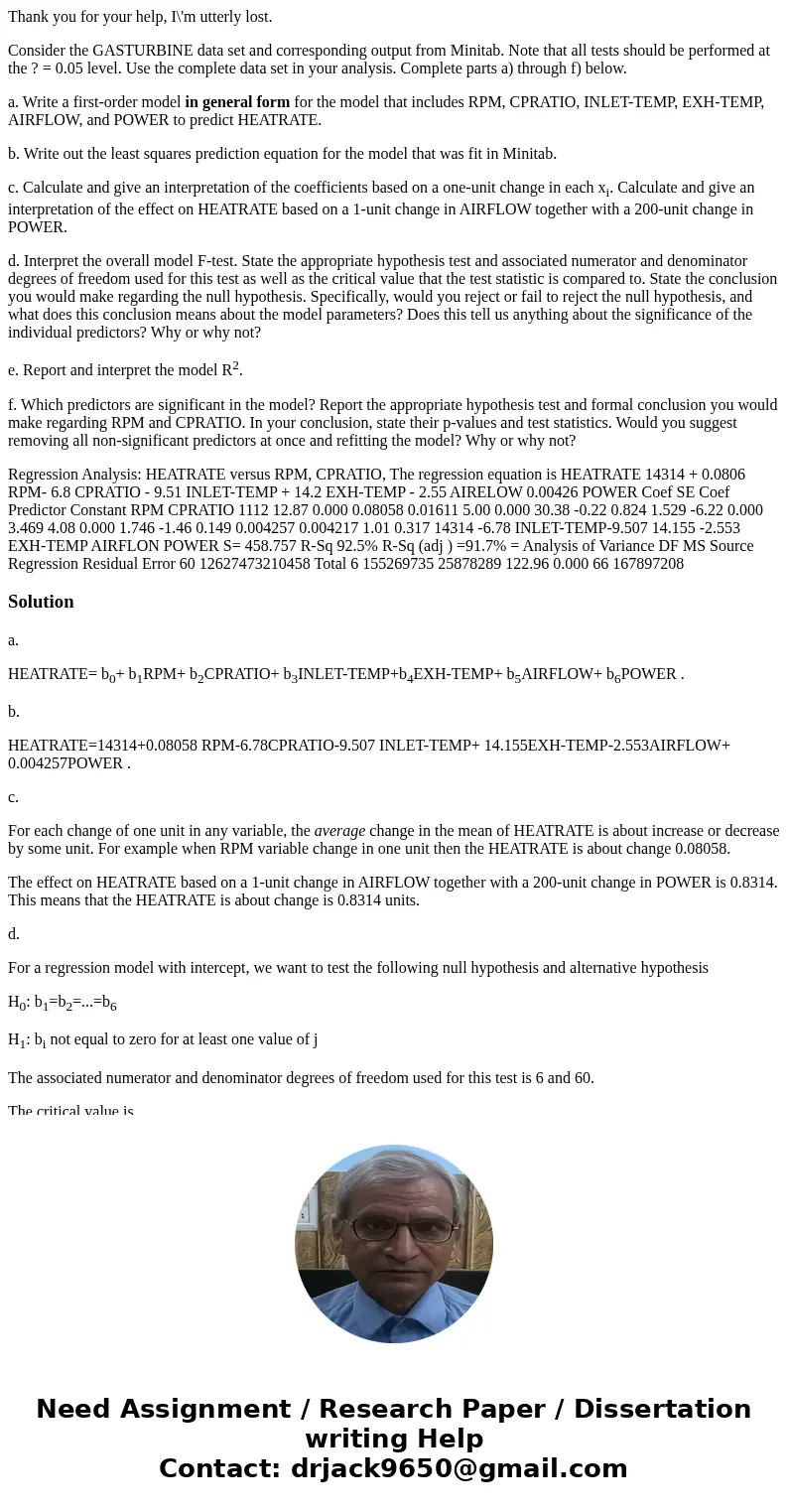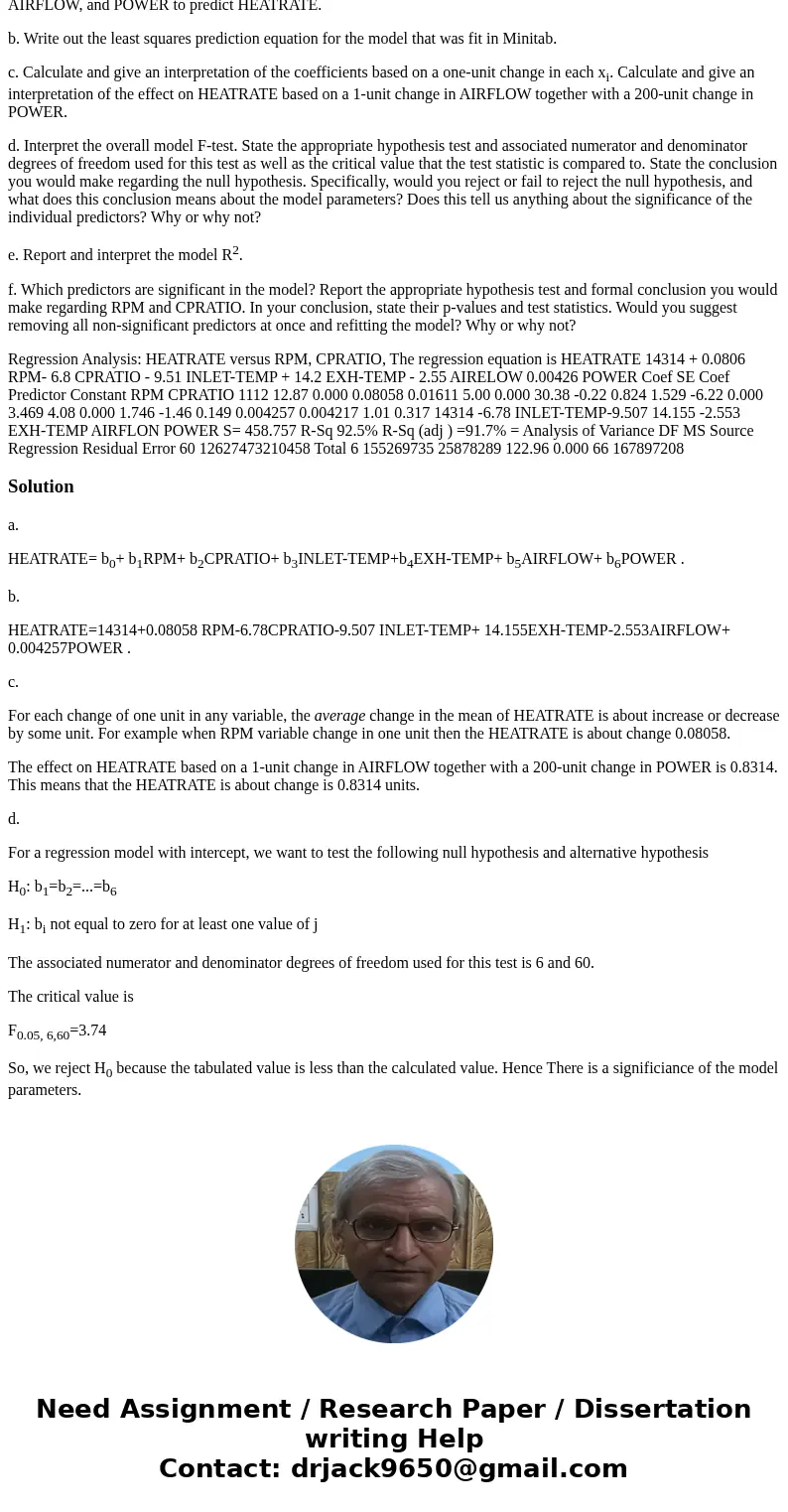Thank you for your help Im utterly lost Consider the GASTURB
Thank you for your help, I\'m utterly lost.
Consider the GASTURBINE data set and corresponding output from Minitab. Note that all tests should be performed at the ? = 0.05 level. Use the complete data set in your analysis. Complete parts a) through f) below.
a. Write a first-order model in general form for the model that includes RPM, CPRATIO, INLET-TEMP, EXH-TEMP, AIRFLOW, and POWER to predict HEATRATE.
b. Write out the least squares prediction equation for the model that was fit in Minitab.
c. Calculate and give an interpretation of the coefficients based on a one-unit change in each xi. Calculate and give an interpretation of the effect on HEATRATE based on a 1-unit change in AIRFLOW together with a 200-unit change in POWER.
d. Interpret the overall model F-test. State the appropriate hypothesis test and associated numerator and denominator degrees of freedom used for this test as well as the critical value that the test statistic is compared to. State the conclusion you would make regarding the null hypothesis. Specifically, would you reject or fail to reject the null hypothesis, and what does this conclusion means about the model parameters? Does this tell us anything about the significance of the individual predictors? Why or why not?
e. Report and interpret the model R2.
f. Which predictors are significant in the model? Report the appropriate hypothesis test and formal conclusion you would make regarding RPM and CPRATIO. In your conclusion, state their p-values and test statistics. Would you suggest removing all non-significant predictors at once and refitting the model? Why or why not?
Regression Analysis: HEATRATE versus RPM, CPRATIO, The regression equation is HEATRATE 14314 + 0.0806 RPM- 6.8 CPRATIO - 9.51 INLET-TEMP + 14.2 EXH-TEMP - 2.55 AIRELOW 0.00426 POWER Coef SE Coef Predictor Constant RPM CPRATIO 1112 12.87 0.000 0.08058 0.01611 5.00 0.000 30.38 -0.22 0.824 1.529 -6.22 0.000 3.469 4.08 0.000 1.746 -1.46 0.149 0.004257 0.004217 1.01 0.317 14314 -6.78 INLET-TEMP-9.507 14.155 -2.553 EXH-TEMP AIRFLON POWER S= 458.757 R-Sq 92.5% R-Sq (adj ) =91.7% = Analysis of Variance DF MS Source Regression Residual Error 60 12627473210458 Total 6 155269735 25878289 122.96 0.000 66 167897208Solution
a.
HEATRATE= b0+ b1RPM+ b2CPRATIO+ b3INLET-TEMP+b4EXH-TEMP+ b5AIRFLOW+ b6POWER .
b.
HEATRATE=14314+0.08058 RPM-6.78CPRATIO-9.507 INLET-TEMP+ 14.155EXH-TEMP-2.553AIRFLOW+ 0.004257POWER .
c.
For each change of one unit in any variable, the average change in the mean of HEATRATE is about increase or decrease by some unit. For example when RPM variable change in one unit then the HEATRATE is about change 0.08058.
The effect on HEATRATE based on a 1-unit change in AIRFLOW together with a 200-unit change in POWER is 0.8314. This means that the HEATRATE is about change is 0.8314 units.
d.
For a regression model with intercept, we want to test the following null hypothesis and alternative hypothesis
H0: b1=b2=...=b6
H1: bi not equal to zero for at least one value of j
The associated numerator and denominator degrees of freedom used for this test is 6 and 60.
The critical value is
F0.05, 6,60=3.74
So, we reject H0 because the tabulated value is less than the calculated value. Hence There is a significiance of the model parameters.


 Homework Sourse
Homework Sourse